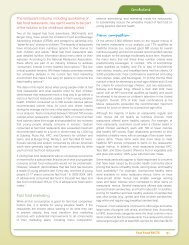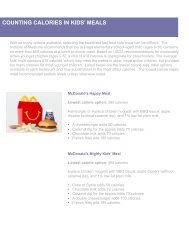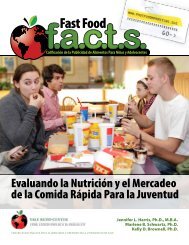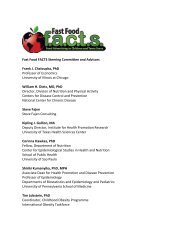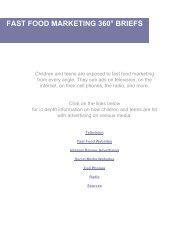Aims and context Why fast food? Introduction - Fast Food FACTS
Aims and context Why fast food? Introduction - Fast Food FACTS
Aims and context Why fast food? Introduction - Fast Food FACTS
Create successful ePaper yourself
Turn your PDF publications into a flip-book with our unique Google optimized e-Paper software.
Restaurants “have an important role to play<br />
in creating a <strong>food</strong> marketing environment that<br />
supports, rather than undermines, the efforts of<br />
parents <strong>and</strong> other caregivers to encourage healthy<br />
eating among children <strong>and</strong> prevent obesity,” 1<br />
according to the White House Task Force on<br />
Childhood Obesity.<br />
The harmful effects of <strong>food</strong> marketing on child <strong>and</strong> adolescent<br />
health have been discussed widely in recent years. In 2006 the<br />
Institute of Medicine (IOM) released a report about children’s<br />
<strong>food</strong> marketing beginning with two words, “marketing works.” 2<br />
In the same year, the World Health Organization (WHO) issued<br />
a report, noting that “…exposure to the commercial promotion<br />
of energy-dense, micronutrient-poor <strong>food</strong>s <strong>and</strong> beverages can<br />
adversely affect children's nutritional status.” 3 Both the IOM<br />
<strong>and</strong> WHO reports highlighted the dire state of children’s <strong>food</strong><br />
marketing <strong>and</strong> called for sweeping changes. These reports<br />
called into question the assertion by <strong>food</strong> industry proponents<br />
that <strong>food</strong> marketing to children only affects br<strong>and</strong> preferences<br />
(e.g., purchases at McDonald’s instead of Burger King) <strong>and</strong><br />
does not increase total purchases of <strong>food</strong> categories such<br />
as <strong>fast</strong> <strong>food</strong>. 4 However, they left open the possibility that <strong>food</strong><br />
companies might be persuaded by good will, public pressure,<br />
or the threat of government regulation to change their marketing<br />
practices.<br />
Much has transpired since the release of the WHO <strong>and</strong> IOM<br />
reports. In the <strong>fast</strong> <strong>food</strong> industry, two of the largest <strong>fast</strong> <strong>food</strong><br />
advertisers (McDonald’s <strong>and</strong> Burger King) have joined the<br />
Children’s <strong>Food</strong> <strong>and</strong> Beverage Advertising Initiative (CFBAI)<br />
<strong>and</strong> pledged to advertise only “better-for-you” choices to<br />
children; 5 the majority of restaurants have introduced more<br />
nutritious options to their menus for both children <strong>and</strong> adults; 6<br />
<strong>and</strong> most <strong>fast</strong> <strong>food</strong> restaurants will soon be required by federal<br />
law to post calories for all items on their menu boards. 7 The<br />
critical question is whether industry promises will reverse the<br />
unhealthy defaults that exist in the current <strong>fast</strong> <strong>food</strong> marketing<br />
environment. 8<br />
Consumption of <strong>fast</strong> <strong>food</strong> is associated with a number of<br />
negative health consequences, most notably unhealthy diet<br />
that increases risk for obesity. 9 10 <strong>Fast</strong> <strong>food</strong> restaurants spend<br />
more than $660 million each year to market their products <strong>and</strong><br />
br<strong>and</strong>s to children <strong>and</strong> adolescents. 11 This report describes<br />
what is being marketed by these restaurants, who they are<br />
targeting <strong>and</strong> how they reach them, <strong>and</strong> what happens when<br />
young people visit <strong>fast</strong> <strong>food</strong> restaurants.<br />
<strong>Aims</strong> <strong>and</strong> <strong>context</strong><br />
In 2008, the Rudd Center for <strong>Food</strong> Policy <strong>and</strong> Obesity at Yale<br />
University received a grant from the Robert Wood Johnson<br />
Foundation to study the amount <strong>and</strong> impact of <strong>food</strong> marketing<br />
directed at children <strong>and</strong> youth. The goal was to highlight both<br />
helpful <strong>and</strong> harmful industry practices by conducting objective,<br />
science-based evaluations of the marketing conducted by<br />
specific companies within different <strong>food</strong> categories, as well<br />
as the nutritional quality of the <strong>food</strong> products promoted. In<br />
2009, we published the Cereal <strong>FACTS</strong> report that provided<br />
a comprehensive review of cereal marketing targeted to<br />
children <strong>and</strong> adolescents (www.CerealFacts.org). We now<br />
focus on the <strong>fast</strong> <strong>food</strong> industry.<br />
<strong>Fast</strong> <strong>Food</strong> <strong>FACTS</strong> quantifies the nutritional quality of <strong>fast</strong> <strong>food</strong><br />
restaurant menus <strong>and</strong> documents the full array of marketing<br />
practices used to promote these restaurants <strong>and</strong> their<br />
products to children <strong>and</strong> adolescents. The data presented<br />
in this report provide a means to evaluate current marketing<br />
practices <strong>and</strong> their impact, <strong>and</strong> offer a metric against which<br />
future changes can be monitored. We incorporate the same<br />
media measurement data used by advertisers to quantify<br />
exposure to TV, radio, <strong>and</strong> digital marketing. We also include<br />
market research data used to monitor competitors’ product<br />
sales. In addition, we conducted our own quantitative <strong>and</strong><br />
qualitative research to measure menu item nutritional quality;<br />
the messages <strong>and</strong> products presented in TV, internet <strong>and</strong><br />
other forms of digital marketing; in-store marketing practices;<br />
<strong>and</strong> parent attitudes about <strong>fast</strong> <strong>food</strong> restaurants. When<br />
possible, we evaluated differences by target populations,<br />
focusing on children, adolescents, <strong>and</strong> African American <strong>and</strong><br />
Hispanic youth. Although this analysis is the most extensive<br />
of its type ever undertaken, we could not evaluate every <strong>fast</strong><br />
<strong>food</strong> restaurant. Therefore, we focused our data collection on<br />
twelve <strong>fast</strong> <strong>food</strong> restaurants, including the ten largest sellers<br />
<strong>and</strong>/or marketers of <strong>fast</strong> <strong>food</strong> to young people.<br />
<strong>Why</strong> <strong>fast</strong> <strong>food</strong>?<br />
<strong>Introduction</strong><br />
During the last several decades, <strong>food</strong> patterns have shifted<br />
in the United States with Americans consuming a greater<br />
proportion of their total calories outside the home. 12 13 In<br />
1994-96, 10% of young people’s caloric intake came from <strong>fast</strong><br />
<strong>food</strong>, a five-fold increase compared to twenty years earlier. 14<br />
Data from the mid-1990s also showed that one third of young<br />
people (4-19 years) ate <strong>fast</strong> <strong>food</strong> every day. 15 Portion sizes<br />
offered by <strong>fast</strong> <strong>food</strong> restaurants also grew during this time<br />
period, with individual items from two to five times larger than<br />
they were when originally introduced. 16 More recent data from<br />
2003-04 indicate that <strong>fast</strong> <strong>food</strong> now contributes 16% to 17% of<br />
adolescents’ total caloric intake, 17 <strong>and</strong> each meal consumed<br />
in a <strong>fast</strong> <strong>food</strong> or other restaurant increases adolescents’ daily<br />
intake by 108 calories. 18<br />
Given the considerable role <strong>fast</strong> <strong>food</strong> plays in young people’s<br />
diets, the nutritional quality of menu items offered in <strong>fast</strong> <strong>food</strong><br />
restaurants is a critical concern. A recent study of the nutrient<br />
quality of children’s meals available at <strong>fast</strong> <strong>food</strong> restaurants<br />
found that only 3% met the nutrition st<strong>and</strong>ards set by the<br />
National School Lunch Program for <strong>food</strong>s served to children<br />
eight years of age <strong>and</strong> younger. 19 That study also found that<br />
less than one-third of these meals provided adequate calcium<br />
or iron <strong>and</strong> more than half exceeded recommended sodium<br />
<strong>Fast</strong> <strong>Food</strong> <strong>FACTS</strong> 12
levels. Additionally, restaurants encourage over-consumption<br />
of these nutrient-poor <strong>food</strong>s by promoting combination meals<br />
that offer price savings for larger portion sizes <strong>and</strong> in-store<br />
signs that encourage unhealthy eating <strong>and</strong> overeating. 20<br />
There is reason to be concerned about the impact of <strong>fast</strong><br />
<strong>food</strong> consumption on young people’s overall nutrition <strong>and</strong><br />
health. Young people who eat <strong>fast</strong> <strong>food</strong> consume more total<br />
fat, added sugars, <strong>and</strong> sugar-sweetened beverages, <strong>and</strong> less<br />
fiber, milk, <strong>and</strong> fruits <strong>and</strong> vegetables compared to children<br />
who do not eat <strong>fast</strong> <strong>food</strong>. 21-23 Greater consumption of <strong>fast</strong><br />
<strong>food</strong> is also associated with higher energy intake overall <strong>and</strong><br />
greater risk of future obesity. 24-26 Adults who visit <strong>fast</strong> <strong>food</strong><br />
restaurants <strong>and</strong> reside in neighborhoods with a high density<br />
of <strong>fast</strong> <strong>food</strong> restaurants <strong>and</strong> low walkability have increased<br />
blood pressure over time. 27 Furthermore, African American<br />
youth, a population that faces some of the highest risks of<br />
obesity <strong>and</strong> obesity-related diseases, consume more <strong>fast</strong><br />
28 29<br />
<strong>food</strong> compared to white children of the same age.<br />
Marketing to young people<br />
In light of increased consumption of <strong>fast</strong> <strong>food</strong> by young people<br />
<strong>and</strong> its negative influence on their diet <strong>and</strong> health, public<br />
health advocates <strong>and</strong> government officials have expressed<br />
concern about marketing that encourages young people<br />
to consume <strong>fast</strong> <strong>food</strong>. In 2006, <strong>fast</strong> <strong>food</strong> restaurants spent<br />
approximately $300 million in marketing specifically designed<br />
to reach young people, more than any <strong>food</strong> category except<br />
for carbonated beverages. 30 <strong>Fast</strong> <strong>food</strong> restaurants spent as<br />
much as marketers of juices, non-carbonated beverages<br />
<strong>and</strong> snack <strong>food</strong>s combined, <strong>and</strong> nearly two <strong>and</strong> a half times<br />
the amount spent for c<strong>and</strong>y <strong>and</strong> frozen desserts. In addition,<br />
<strong>fast</strong> <strong>food</strong> marketers spent an estimated $360 million on toys<br />
distributed as premiums with children’s meals. When added<br />
to their other marketing expenditures, spending on <strong>fast</strong> <strong>food</strong><br />
marketing programs targeted to children <strong>and</strong> teens totaled<br />
$660 million. This amount is more than 200 times the $3 million<br />
communications budget for the “5 A Day” campaign, a joint<br />
venture with the National Cancer Institute (NCI) <strong>and</strong> the <strong>food</strong><br />
industry, to encourage fruit <strong>and</strong> vegetable consumption. 31<br />
Approximately two-thirds of <strong>fast</strong> <strong>food</strong> marketing budgets was<br />
spent on traditional TV <strong>and</strong> radio advertising. 32 In 2007, <strong>fast</strong><br />
<strong>food</strong> advertising comprised 22% of TV <strong>food</strong> ads viewed by<br />
children (ages 6 to 11 years) <strong>and</strong> 28% of those viewed by<br />
adolescents. 33 Children <strong>and</strong> adolescents viewed more ads for<br />
<strong>fast</strong> <strong>food</strong>s than for any other <strong>food</strong> category. The average U.S.<br />
child viewed 1,058 TV ads for <strong>fast</strong> <strong>food</strong> annually, or 2.9 ads<br />
every day, <strong>and</strong> adolescents viewed even more: almost 1,500<br />
per year, or 4.1 per day. These marketing efforts begin as<br />
early as preschool: 66% of child-targeted advertising during<br />
preschool programming promoted <strong>fast</strong> <strong>food</strong> restaurants. 34<br />
<strong>Fast</strong> <strong>food</strong> companies also spent considerable sums on youthtargeted<br />
radio advertising; cross-promotions, <strong>and</strong> other tieins<br />
with philanthropies <strong>and</strong> athletic sponsorships; product<br />
packaging <strong>and</strong> in-store marketing; <strong>and</strong> in-school <strong>and</strong> events<br />
marketing (see Figure 1). 35 <strong>Fast</strong> <strong>food</strong> br<strong>and</strong>s also commonly<br />
use digital marketing techniques, including social media, ingame<br />
marketing, <strong>and</strong> viral media to increase the appeal of<br />
their products to young people. 36<br />
Schools/events<br />
$18 mill.<br />
Packaging/in-store<br />
$22 mill.<br />
Promotions<br />
$30 mill.<br />
Radio<br />
$30 mill.<br />
TV<br />
$187 mill.<br />
<strong>Introduction</strong><br />
Other<br />
$7 mill.<br />
Toy giveaways<br />
$360 mill.<br />
Figure 1: Spending by <strong>fast</strong> <strong>food</strong> restaurants on marketing<br />
directly targeted to children <strong>and</strong> adolescents<br />
There is considerable evidence that exposure to marketing<br />
for <strong>fast</strong> <strong>food</strong> is even higher among African American <strong>and</strong><br />
Hispanic youth. 38 African American youth view almost 50%<br />
more TV advertisements for <strong>fast</strong> <strong>food</strong> than do white children <strong>and</strong><br />
adolescents. 39 Although differences in advertising exposure<br />
can be attributed in large part to the greater amount of time<br />
that African American <strong>and</strong> Hispanic youth spend watching<br />
television, 40 <strong>fast</strong> <strong>food</strong> restaurants appear to disproportionately<br />
target African Americans <strong>and</strong> Hispanics with their marketing<br />
efforts. For example, <strong>fast</strong> <strong>food</strong> ads appear more frequently<br />
during African American-targeted TV programming than during<br />
general audience programming. 41 <strong>Fast</strong> <strong>food</strong> advertisements<br />
are also prevalent on Spanish-language television networks,<br />
comprising nearly half of all ads. 42 Billboards for <strong>fast</strong> <strong>food</strong><br />
restaurants appear significantly more often in low-income<br />
African American <strong>and</strong> Latino neighborhoods. 43 <strong>Fast</strong> <strong>food</strong><br />
restaurants located in poorer African American neighborhoods<br />
also promote less-healthful <strong>food</strong>s <strong>and</strong> have more in-store<br />
advertisements compared to restaurants in more affluent,<br />
predominantly white neighborhoods. 44<br />
The 2010 report by the White House Task Force on Childhood<br />
Obesity explicitly addresses the potentially harmful effects of<br />
<strong>fast</strong> <strong>food</strong> marketing, noting the frequency with which children<br />
eat at <strong>fast</strong> <strong>food</strong> restaurants <strong>and</strong> calling on restaurants to<br />
“consider their portion sizes, improve children’s menus, <strong>and</strong><br />
make healthy options the default choice whenever possible.” 45<br />
<strong>Fast</strong> <strong>Food</strong> <strong>FACTS</strong> 13
Recent restaurant industry initiatives to<br />
address childhood obesity<br />
The restaurant industry has responded to concerns about<br />
the nutritional quality of their products <strong>and</strong> the volume of<br />
marketing targeted to young people. According to the<br />
National Restaurant Association, “two-thirds of quickserve<br />
operators offer more healthful choices for children than they<br />
did two years ago,” 46 <strong>and</strong> McDonald’s says that, “any fair <strong>and</strong><br />
objective review of our menu <strong>and</strong> the actions we’ve taken<br />
will demonstrate we’ve been responsible, we’re committed<br />
to children’s well-being, <strong>and</strong> we’ll continue to do more.” 47<br />
The two largest <strong>fast</strong> <strong>food</strong> marketers to children, McDonald’s<br />
<strong>and</strong> Burger King, joined the Children’s <strong>Food</strong> <strong>and</strong> Beverage<br />
Initiative (CFBAI), an industry-sponsored program to “change<br />
the l<strong>and</strong>scape of child-directed advertising.” 48 As members<br />
of the CFBAI, these two restaurants have pledged to depict<br />
only “pledge-approved, better-for-you” products in their<br />
child-directed measured media (i.e., television, radio, thirdparty<br />
internet <strong>and</strong> print), company-owned websites <strong>and</strong><br />
interactive games. These pledges were fully implemented by<br />
the beginning of 2009.<br />
While the CFBAI represents an industry-led effort to reduce<br />
unhealthy marketing to children, numerous omissions <strong>and</strong><br />
loopholes raise questions about the <strong>fast</strong> <strong>food</strong> industry’s<br />
commitment to change the l<strong>and</strong>scape of children’s <strong>food</strong><br />
advertising. For example, only McDonald’s <strong>and</strong> Burger King<br />
had joined the initiative as of September 2010. 49 These<br />
two restaurants are the largest advertisers to children on<br />
television. However, other restaurants contribute more than<br />
half of the <strong>fast</strong> <strong>food</strong> ads children view. 50 Notably, Subway <strong>and</strong><br />
YUM! Br<strong>and</strong>s, whose restaurants include KFC, Taco Bell, <strong>and</strong><br />
Pizza Hut, had not joined the CFBAI at the time of this report’s<br />
publication. So in spite of reductions in children’s exposure<br />
to McDonald’s <strong>and</strong> Burger King advertising on television,<br />
children’s exposure to all <strong>fast</strong> <strong>food</strong> TV advertising increased<br />
by 12% from 2003 to 2007. 51 This increase occurred at the<br />
same time that children’s exposure to TV advertising for other<br />
product categories (including beverages, cereal, c<strong>and</strong>y, <strong>and</strong><br />
snacks) decreased.<br />
Another significant limitation of the CFBAI is that it only<br />
addresses advertising to children younger than age 12. As<br />
discussed, adolescents view 40% more television advertising<br />
for <strong>fast</strong> <strong>food</strong> than children do, 52 <strong>and</strong> many young people of this<br />
age have the means to visit these restaurants on their own. A<br />
survey of middle <strong>and</strong> high school students found that 77% of<br />
boys <strong>and</strong> 72% of girls reported visiting a <strong>fast</strong> <strong>food</strong> restaurant in<br />
the past week, 53 <strong>and</strong> a more recent study indicated that 59% of<br />
adolescents (12-19 years) consumed <strong>fast</strong> <strong>food</strong> on at least one<br />
of the two previous days. 54<br />
Finally, the CFBAI does not address all forms of marketing to<br />
young people. For example, <strong>fast</strong> <strong>food</strong> restaurants spent $22<br />
million on packaging <strong>and</strong> other marketing in the restaurant<br />
targeted to young people, as well as $9 million on marketing<br />
in schools. However, neither of these forms of marketing is<br />
<strong>Introduction</strong><br />
covered by the CFBAI. The initiative also does not include<br />
the 91% of <strong>fast</strong> <strong>food</strong> restaurants’ spending on philanthropic<br />
marketing programs (more than $10 million) which was<br />
reported as youth-targeted marketing expenditures. Similarly,<br />
the CFBAI does not address marketing programs that<br />
disproportionately appeal to young people if they are not the<br />
primary target audience. Examples include TV advertising<br />
on general audience programming with wide youth appeal,<br />
such as “American Idol” or “Glee,” <strong>and</strong> br<strong>and</strong>ed games on<br />
company websites (known as advergames).<br />
These limitations to the CFBAI <strong>and</strong> other <strong>fast</strong> <strong>food</strong> industry<br />
actions have led public health advocates to question whether<br />
restaurant industry initiatives are intended to improve public<br />
health or merely deflect concerns about their products <strong>and</strong><br />
marketing efforts. For example, McDonald’s pledged to market<br />
only apple dippers <strong>and</strong> 1% low-fat white milk in their Happy<br />
Meal advertisements targeted to children. However, a recent<br />
examination by the Center for Science in the Public Interest<br />
found that 93% of the time shoppers were automatically given<br />
french fries when ordering a Happy Meal. 55 In addition, the<br />
National Restaurant Association lobbied extensively against<br />
a recent bill passed in Santa Clara County, California that<br />
requires <strong>fast</strong> <strong>food</strong> kids’ meals that come with a toy to meet<br />
minimum nutrition st<strong>and</strong>ards.<br />
Meanwhile, purchases of unhealthy options continue to be the<br />
norm at <strong>fast</strong> <strong>food</strong> restaurants. During 2008-2009, only 5% of<br />
children ordered fruit <strong>and</strong> 14% ordered plain milk or 100%<br />
juice at <strong>fast</strong> <strong>food</strong> restaurants. 56 Additionally, from 2005 to<br />
2008, the ordering of kids’ meals by children (under 13 years)<br />
declined by 11% while orders of typically higher-calorie items<br />
from dollar or value menus increased by 9%, according to<br />
The NPD Group (NPD), a market research firm that tracks<br />
product purchases at restaurants by age group. 57 Snack <strong>food</strong><br />
purchases also increased during the same period. “Kids<br />
today want more choices <strong>and</strong> sophisticated fare,” said an<br />
NPD spokesperson.<br />
Given the damaging effects of <strong>fast</strong> <strong>food</strong> on young people’s<br />
health, it is imperative that young people consume less of<br />
the calorie-dense nutrient-poor <strong>food</strong>s served at <strong>fast</strong> <strong>food</strong><br />
restaurants. The <strong>food</strong> industry has pledged to offer healthier<br />
options for consumers who choose them <strong>and</strong> to improve their<br />
marketing practices targeted to children. They must also curb<br />
marketing practices that aggressively promote less healthful<br />
products to all young people <strong>and</strong> implement practices inside<br />
restaurants to encourage purchases of the more nutritious<br />
options on their menus.<br />
On creating a transparent, open, <strong>and</strong><br />
objective process<br />
This report addresses the need for comprehensive, reliable,<br />
<strong>and</strong> current information about <strong>fast</strong> <strong>food</strong> marketing practices<br />
<strong>and</strong> how these practices affect young people’s <strong>fast</strong> <strong>food</strong><br />
purchases. It also examines the nutritional quality of current<br />
<strong>Fast</strong> <strong>Food</strong> <strong>FACTS</strong> 14
<strong>fast</strong> <strong>food</strong> menus. The data presented in this report <strong>and</strong> our<br />
methods are described in detail. We use the best available<br />
syndicated marketing data <strong>and</strong> strategic studies to fill<br />
important gaps in knowledge. We developed the scope of<br />
the report <strong>and</strong> collected information for it based on detailed<br />
reviews of the literature <strong>and</strong> multiple discussions with experts<br />
in the field, including with the nutrition, marketing, <strong>and</strong> public<br />
health experts who serve on our advisory committee.<br />
Despite our best efforts, we acknowledge that no piece<br />
of scientific work is perfect. We learned a great deal from<br />
developing the Cereal <strong>FACTS</strong> report <strong>and</strong> have incorporated<br />
feedback from that report to build upon <strong>and</strong> improve the<br />
research methods for <strong>Fast</strong> <strong>Food</strong> <strong>FACTS</strong>. In addition, we have<br />
revised the methods used to evaluate the nutritional quality<br />
of <strong>fast</strong> <strong>food</strong> menu items to take into account the complexity<br />
of the wide variety of menu items offered. We also developed<br />
new methods to evaluate forms of marketing used extensively<br />
by the <strong>fast</strong> <strong>food</strong> industry, including radio <strong>and</strong> social <strong>and</strong><br />
mobile marketing. Finally, we incorporate data in this report to<br />
quantify <strong>and</strong> evaluate <strong>fast</strong> <strong>food</strong> purchases by <strong>and</strong> for young<br />
people.<br />
Although we provide a thorough evaluation of <strong>fast</strong> <strong>food</strong><br />
marketing to young people, it is not possible to quantify all<br />
Figure 2. Model of <strong>fast</strong> <strong>food</strong> marketing components, strategies, <strong>and</strong> outcomes<br />
Marketing Components<br />
Individual menu items<br />
Special menus<br />
Nutritional quality<br />
Target audiences<br />
Children<br />
Teens<br />
African American youth<br />
Hispanic youth<br />
Advertising spending<br />
Television ads<br />
Internet marketing<br />
Social media<br />
Mobile marketing<br />
Outside signs<br />
External advertising<br />
Restaurant visits<br />
Product choice<br />
Br<strong>and</strong> affinity/loyalty<br />
Marketing messages<br />
Kids love it<br />
Value<br />
Nutrition/health<br />
New/unique<br />
Eating occasions<br />
<strong>Introduction</strong><br />
types of <strong>fast</strong> <strong>food</strong> marketing targeted to them <strong>and</strong> evaluate<br />
their impact. We invite further feedback from interested parties<br />
as we continue to refine our methods <strong>and</strong> update our data to<br />
make the information as valid <strong>and</strong> accurate as possible.<br />
<strong>Fast</strong> <strong>Food</strong> <strong>FACTS</strong> report<br />
In this report, we examine three elements of <strong>fast</strong> <strong>food</strong> marketing<br />
plans: specific marketing programs used to promote <strong>fast</strong> <strong>food</strong><br />
products, marketing strategies used in these programs, <strong>and</strong><br />
the impact of these marketing efforts on customer attitudes<br />
<strong>and</strong> behaviors (see Figure 2). We focus our analysis on the<br />
twelve restaurants with the highest sales <strong>and</strong> advertising to<br />
youth.<br />
We quantify three major marketing components used by <strong>fast</strong><br />
<strong>food</strong> restaurants in their marketing plans: menu composition,<br />
or the <strong>food</strong> products offered for sale at the restaurants;<br />
external advertising, comprised of marketing practices such<br />
as TV advertising <strong>and</strong> internet marketing designed to pull<br />
customers into the restaurants; <strong>and</strong> in-store marketing, or<br />
advertising <strong>and</strong> promotion that occurs within the restaurant,<br />
including signs, pricing, <strong>and</strong> sales practices, to push sales of<br />
individual menu items.<br />
Promotions<br />
Toy giveaways<br />
Other promotions<br />
Special pricing<br />
In-store signs<br />
Sales practices<br />
Pricing<br />
Menu composition In-store marketing<br />
Marketing Outcomes<br />
Marketing<br />
Strategies<br />
<strong>and</strong> Tactics<br />
Parent survey<br />
NPD purchase data<br />
Br<strong>and</strong> engagement<br />
Interactive content<br />
Emotional associations<br />
<strong>Fast</strong> <strong>Food</strong> <strong>FACTS</strong> 15
We also examine marketing strategies used across the<br />
different marketing components. These include targeted<br />
marketing practices that appeal to different age groups,<br />
including preschool children, elementary school-age<br />
children, <strong>and</strong> adolescents, as well as marketing practices that<br />
disproportionately reach or appeal to African American <strong>and</strong><br />
Hispanic youth. These minority populations face higher risks<br />
of obesity <strong>and</strong> obesity-related diseases <strong>and</strong>, therefore, the<br />
nutritional quality of <strong>food</strong>s targeted to these groups warrant<br />
58 59<br />
close attention.<br />
We assess the messages commonly used by <strong>fast</strong> <strong>food</strong><br />
restaurants to communicate the benefits of their products,<br />
including “kids love it,” “good value,” “healthy” or “lowcalorie,”<br />
“new” or “different,” <strong>and</strong> good for specific eating<br />
occasions (e.g., snack, break<strong>fast</strong>, late-night). We also<br />
evaluate promotional tactics frequently used by <strong>fast</strong> <strong>food</strong><br />
restaurants, including toy giveaways with kids’ meals, other<br />
tie-ins with entertainment companies <strong>and</strong> charities, <strong>and</strong><br />
limited time offers for special pricing or <strong>food</strong> giveaways for<br />
specific menu items. In addition, we examine tactics that<br />
encourage br<strong>and</strong> engagement, or extended involvement with<br />
a restaurant br<strong>and</strong>, such as interactive content in internet <strong>and</strong><br />
social media or tactics that encourage emotional associations<br />
with a restaurant.<br />
Finally, we begin to quantify the marketing outcomes<br />
encouraged by these marketing practices. When <strong>fast</strong> <strong>food</strong><br />
restaurants market their products, they not only encourage<br />
frequency of restaurant visits, they also influence consumers’<br />
product choices, or the menu items ordered during those<br />
restaurant visits. Particularly in the case of marketing to young<br />
people, these marketing practices may also create br<strong>and</strong><br />
loyalty <strong>and</strong> affinity, or long-term preferences <strong>and</strong> positive<br />
feelings about the restaurants.<br />
Research design<br />
For each of the marketing components, we assess several<br />
specific marketing practices <strong>and</strong> strategies for the twelve<br />
restaurants in our analysis. When available, we also provide<br />
data for the <strong>fast</strong> <strong>food</strong> industry in total.<br />
■ Menu composition research provides nutrient content data<br />
on all regular items on restaurant menus as of January 15,<br />
2010. We also characterize menu items by <strong>food</strong> category<br />
<strong>and</strong> special menus (i.e., kids’ meals, dollar/value menus,<br />
<strong>and</strong> healthy menus) <strong>and</strong> evaluate the nutritional quality<br />
of individual menu items. Finally, we compare nutritional<br />
quality of <strong>food</strong> categories <strong>and</strong> special menus by restaurant.<br />
■ External advertising research includes both quantitative<br />
<strong>and</strong> qualitative data to measure advertising practices that<br />
reach consumers outside of the restaurant. These practices<br />
include spending on advertising media, TV advertising,<br />
<strong>Introduction</strong><br />
internet marketing (including company-sponsored<br />
websites <strong>and</strong> advertising on third-party websites), social<br />
<strong>and</strong> viral media (including Facebook, Twitter, <strong>and</strong> YouTube),<br />
mobile marketing, <strong>and</strong> signs outside the restaurants. To<br />
quantify young people’s exposure to these different forms<br />
of advertising, we used syndicated data from The Nielsen<br />
Company (Nielsen), comScore Inc., <strong>and</strong> Arbitron Inc.<br />
When this information was not available, we commissioned<br />
or implemented our own studies to measure the extent<br />
that individual restaurants engage in these practices. In<br />
addition, we conducted content analyses of the different<br />
forms of marketing to assess the products, target<br />
audiences, messages, <strong>and</strong> techniques presented in the<br />
advertisements.<br />
■ In-store marketing research presents quantitative <strong>and</strong><br />
qualitative data to assess marketing practices inside the<br />
restaurants that encourage sales of specific products.<br />
We present results of an audit of signs located within the<br />
restaurants <strong>and</strong> at drive-thru lanes; a study of restaurant<br />
sales practices that documents products encouraged at the<br />
point-of-sale when ordering kids’ meals <strong>and</strong> combo meals;<br />
<strong>and</strong> special pricing options promoted within the restaurants.<br />
We also conducted a content analysis of the products,<br />
target audiences, <strong>and</strong> other promotions presented on instore<br />
signs.<br />
To measure the outcomes of these practices, we purchased<br />
market research data from The NPD Group (NPD) that quantifies<br />
the types of <strong>food</strong> products purchased most often using their<br />
Consumer Reports on Eating Share Trends (CREST) data. We<br />
combined these numbers with our nutrient content data to<br />
evaluate the overall nutritional quality of products purchased<br />
by young people at the twelve restaurants in our analysis. We<br />
also conducted a survey of parents of 2- to 11-year-olds to<br />
underst<strong>and</strong> how often they visit <strong>fast</strong> <strong>food</strong> restaurants with their<br />
children, what items they purchase for their children, <strong>and</strong> why.<br />
This research is detailed in the following pages <strong>and</strong> organized<br />
into five sections:<br />
■ Methods details the data sources, procedures, <strong>and</strong><br />
calculations used to collect <strong>and</strong> analyze the data;<br />
■ Results presents the detailed findings of each of these<br />
analyses;<br />
■ Conclusion summarizes the findings <strong>and</strong> discusses<br />
implications <strong>and</strong> recommendations for further improvements<br />
in <strong>fast</strong> <strong>food</strong> restaurant products <strong>and</strong> marketing practices;<br />
■ Ranking Tables compare the nutritional quality <strong>and</strong><br />
marketing practices of different restaurants, <strong>and</strong><br />
■ The Appendices provide the detailed data that are<br />
summarized in the Results.<br />
<strong>Fast</strong> <strong>Food</strong> <strong>FACTS</strong> 16




